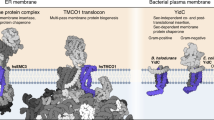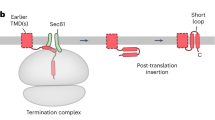Abstract
POSITIVELY charged amino acids have been shown to be important elements in targeting-peptides that direct proteins into mitochon-dria, nuclei, and the secretory pathways of both prokaryotic and eukaryotic cells1. The 'positive-inside' rule, which observes that regions of polytopic (multi-spanning) membrane proteins facing the cytoplasm are generally enriched in arginyl and lysyl residues whereas translocated regions are largely devoid of these residues2,3, implies that the distribution of positively charged amino acids may also be a major determinant of the transmembrane topology of integral membrane proteins. If this is indeed the case, it should be possible to predictably alter the topology of a polytopic protein by site-directed insertions and/or deletions of positively charged residues in critical locations. I now describe a derivative of Escherichia coli leader peptidase, a polytopic inner-membrane protein, that switches from sec-gene-dependent membrane insertion with a Nout−Cout transmembrane topology to sec-gene-independent insertion with a Nin−Cin topology in response to the addition of four positively charged lysines to its N terminus.
This is a preview of subscription content, access via your institution
Access options
Subscribe to this journal
Receive 51 print issues and online access
$199.00 per year
only $3.90 per issue
Buy this article
- Purchase on Springer Link
- Instant access to full article PDF
Prices may be subject to local taxes which are calculated during checkout
Similar content being viewed by others
References
von Heijne, G. Biochim. biophys. Acta. 947, 307–333 (1988).
von Heijne, G. EMBO J. 5, 3021–3027 (1986).
von Heijne, G. & Gavel, Y. Eur. J. Biochem. 174, 671–678 (1988).
Wolfe, P. B., Wickner, W. & Goodman, J. J. biol. Chem. 258, 12073–12080 (1983).
Moore, K. & Miura, S. J. biol. Chem. 262, 8806–8813 (1987).
Dalbey, R. E. & Wickner, W. Science 235, 783–787 (1987).
Dalbey, R. E., Kuhn, A. & Wickner, W. J. biol. Chem. 262, 13241–13245 (1987).
von Heijne, G., Wickner, W. & Dalbey, R. Proc. natn. Acad. Sci. U.S.A. 85, 3363–3366 (1988).
Wolfe, P. B., Rice, M. & Wickner, W. J. biol. Chem. 260, 1836–1841 (1985).
Flinta, C., Persson, B., Jörnvall, H. & von Heijne, G. Eur. J. Biochem. 154, 193–196 (1986).
Laws, J. K. & Dalbey, R. E. EMBO J. 8, 2095–2099 (1989).
Kuhn, A., Kreil, G. & Wickner, W. EMBO J. 6, 501–505 (1987).
Kuhn, A. Eur. J. Biochem. 177, 267–271 (1988).
Kunkel, T. A. Proc. natn. Acad. Sci. U.S.A. 82, 488–492 (1985).
Johnston, S., Lee, J.-H. & Ray, D. S. Gene 34, 137–145 (1985).
Author information
Authors and Affiliations
Rights and permissions
About this article
Cite this article
vonHeijne, G. Control of topology and mode of assembly of a polytopic membrane protein by positively charged residues. Nature 341, 456–458 (1989). https://doi.org/10.1038/341456a0
Received:
Accepted:
Issue Date:
DOI: https://doi.org/10.1038/341456a0
This article is cited by
-
A method for structure determination of GPCRs in various states
Nature Chemical Biology (2024)
-
Expression of Xanthorhodopsin in Escherichia coli
The Protein Journal (2023)
-
Orchestration of signaling by structural disorder in class 1 cytokine receptors
Cell Communication and Signaling (2020)
-
Structure of human steroid 5α-reductase 2 with the anti-androgen drug finasteride
Nature Communications (2020)
-
Constructing Supported Cell Membranes with Controllable Orientation
Scientific Reports (2019)
Comments
By submitting a comment you agree to abide by our Terms and Community Guidelines. If you find something abusive or that does not comply with our terms or guidelines please flag it as inappropriate.



